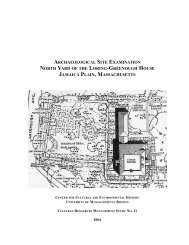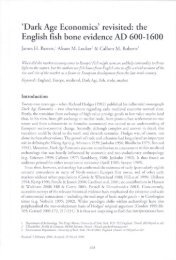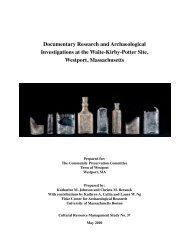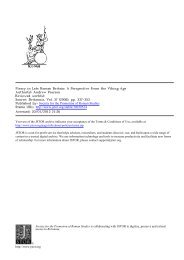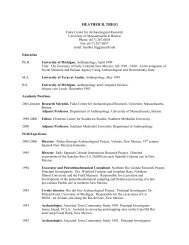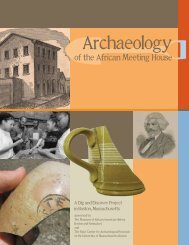Excavations at Glaumbær - Fiske Center
Excavations at Glaumbær - Fiske Center
Excavations at Glaumbær - Fiske Center
Create successful ePaper yourself
Turn your PDF publications into a flip-book with our unique Google optimized e-Paper software.
south room [35]. An area of turf overlaying a stone pavement in the southern half of the<br />
trench and extending into the passage way [34] to the south room [35] suggests the<br />
possibility of internal divisions in the room, perhaps different work or storage spaces.<br />
Figure 4. The middle room with plan of 2002 test trench.<br />
The South Room, Possible Smithy [35]<br />
The South Room [35] was not fully exposed and we have not defined the southern most<br />
extent of the room through excav<strong>at</strong>ion. The southern most extent of the longhouse was<br />
plowed in the spring of 2005, before the season’s investig<strong>at</strong>ions began. The plowing,<br />
while rel<strong>at</strong>ively shallow (c. 30-50 cm) has damaged the upper portion of the site. A small<br />
section of the plowed area was exposed during the excav<strong>at</strong>ion and wall remains are<br />
preserved under the current plow horizon. The plowing is particularly worrisome in this<br />
part of the structure as the surface topography slopes down significantly <strong>at</strong> this end of the<br />
site and floor layers better protected under think deposits in the site center may be closer<br />
to the surface <strong>at</strong> the south end. The plowed area currently covers the still undefined<br />
southernmost extent of the longhouse. At present only one entrance to the room has been<br />
identified, the passage [34] connecting it to the middle room [33]. This does not rule out<br />
the possibility of an additional entrance <strong>at</strong> the southern end of the room, possibly cre<strong>at</strong>ing<br />
an additional external entrance to the longhouse.<br />
The southern end of the longhouse appears to have been associ<strong>at</strong>ed with iron working or<br />
production <strong>at</strong> some point in its existence. Deposits [13] and [14] contain pe<strong>at</strong> ash,<br />
charcoal and slag, including some large pieces gre<strong>at</strong>er than 10 cm in diameter. Slag and<br />
8



